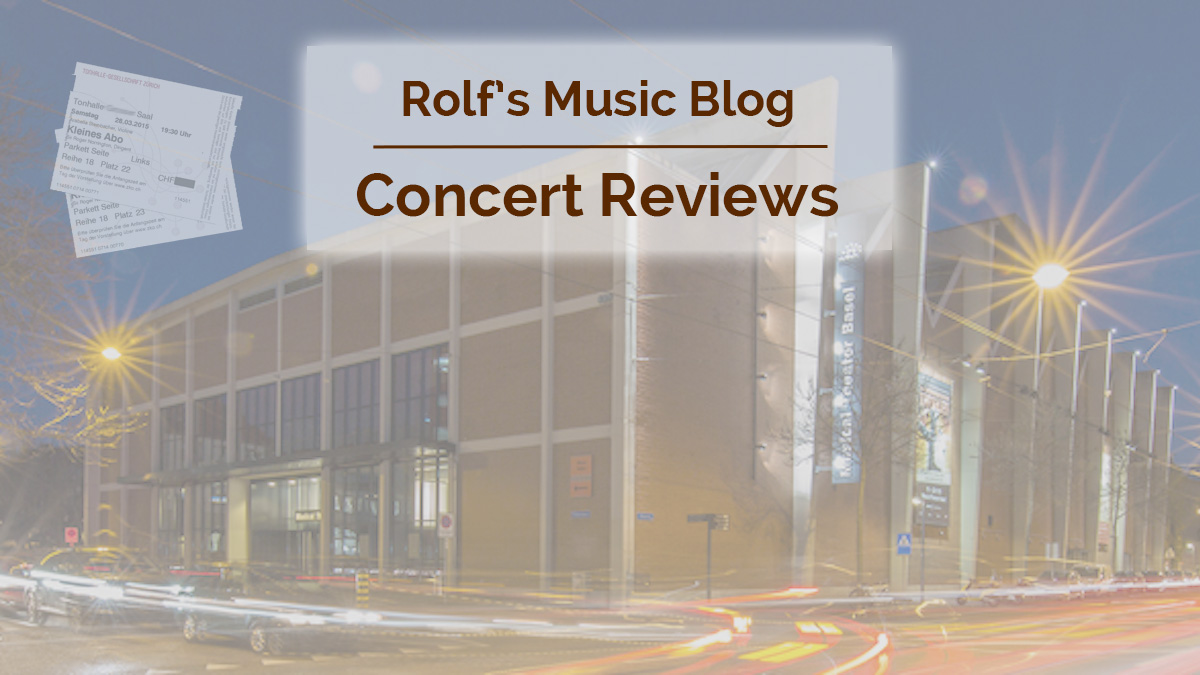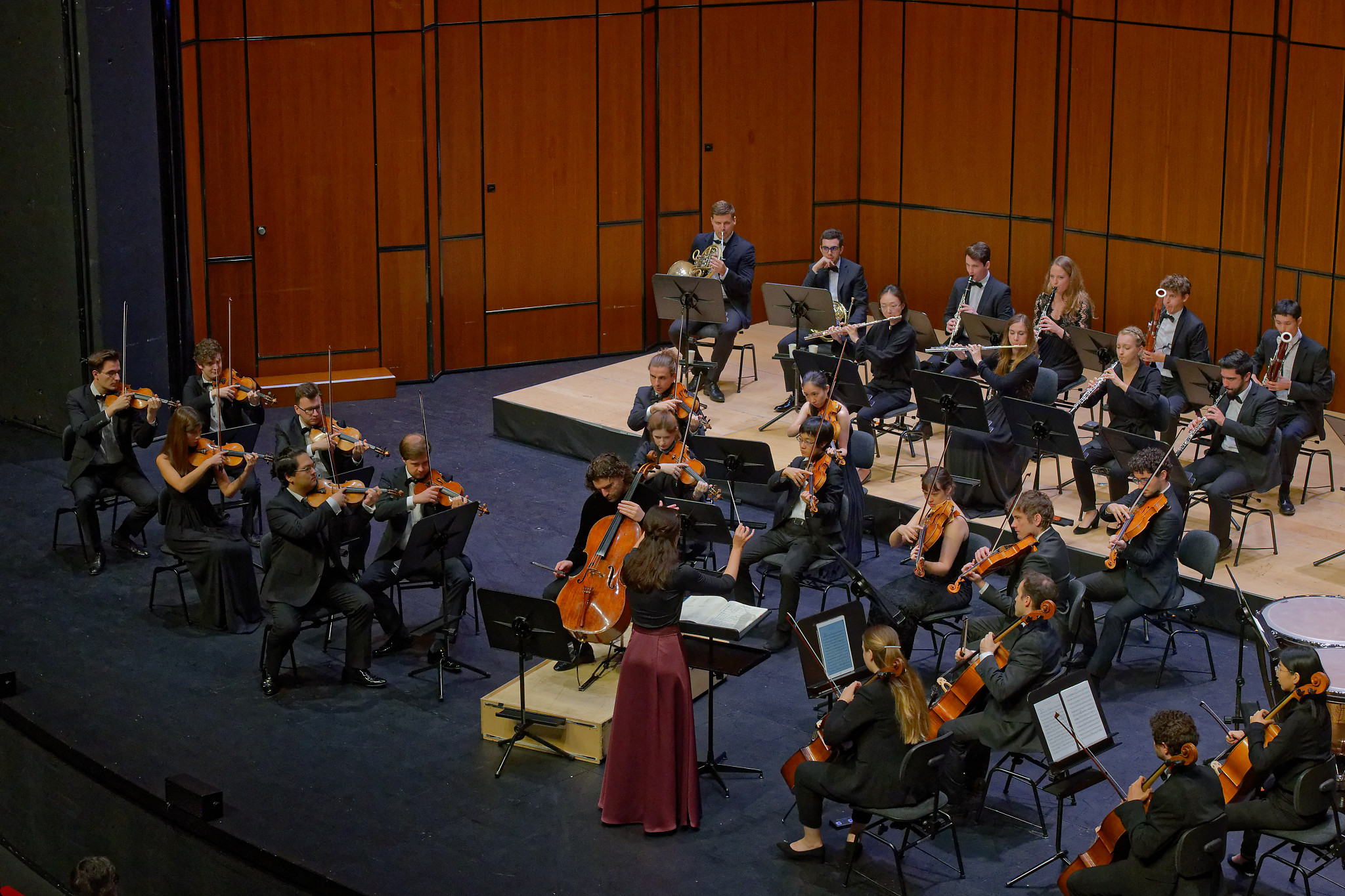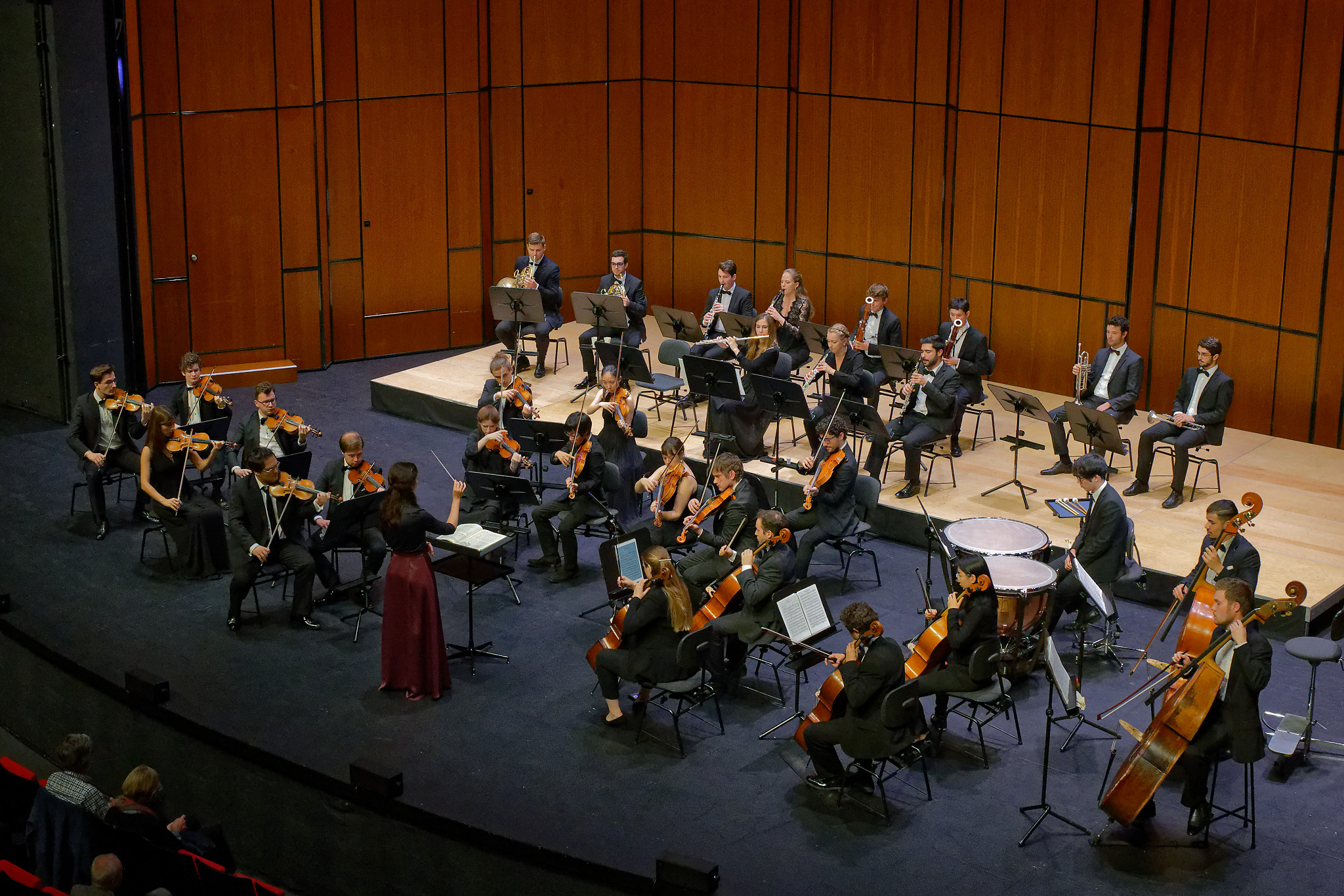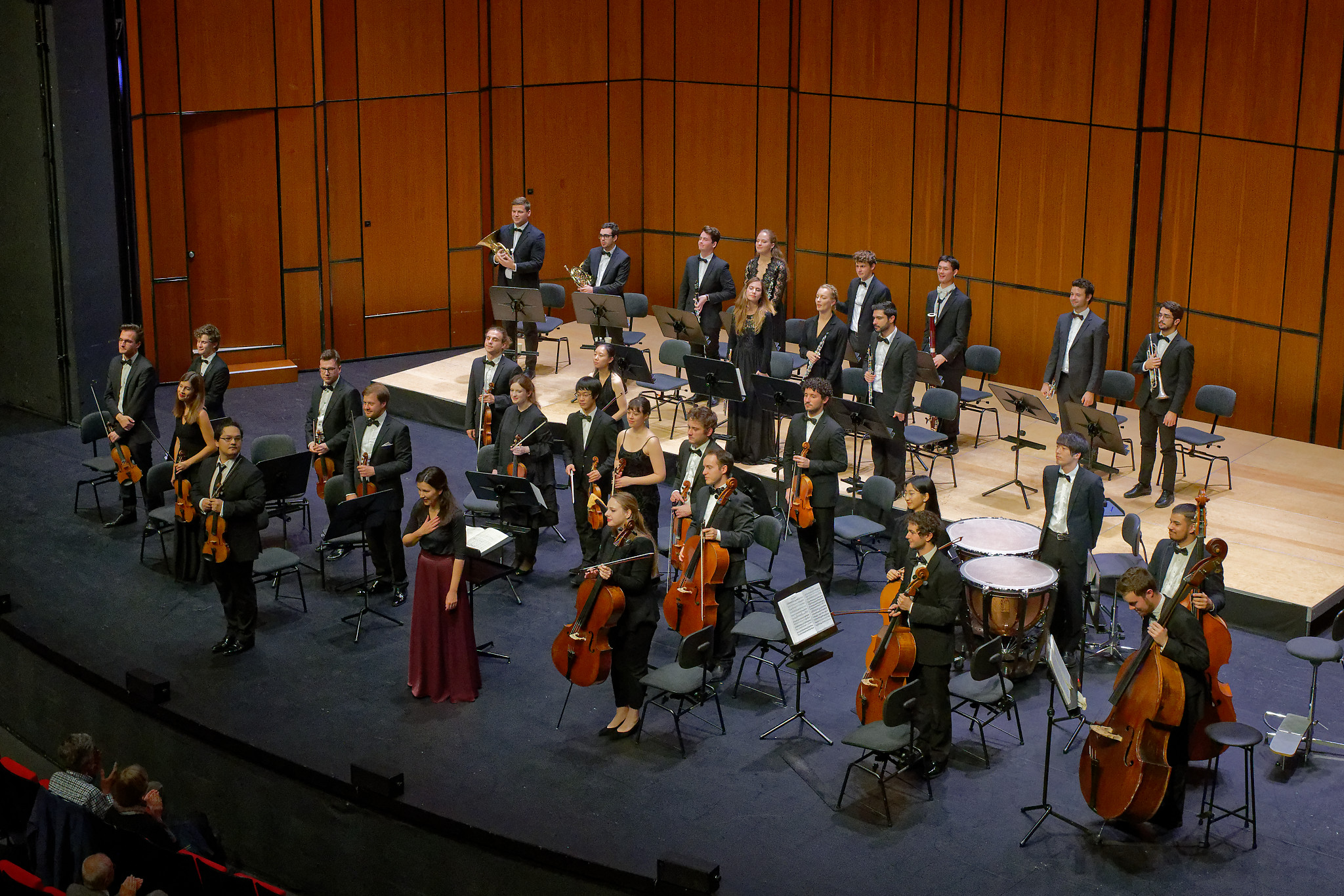Gavriel Lipkind, Adrija Čepaitė / YES Orchestra
Schumann / Beethoven
Musical Theater, Basel, 2019-09-26

2019-10-02 — Original posting
Ein nicht zu bändigender Solist, ein Orchester aus jungen Virtuosen unter kompetenter Leitung — Zusammenfassung
Nur vier Monate nach dem letzten Konzert des YES Orchestra (Junge Eurasische Solisten) unter der litauischen Dirigentin Adrija Čepaitė präsentierten sich die selben Musikerinnen und Musiker erneut im Musical Theater Basel. Diesmal war der Solist der (jetzt in Deutschland ansäßige) Israeli Gavriel Lipkind am Cello, mit einer sehr eigenwilligen Interpretation von Robert Schumanns Cellokonzert in a-moll, op.129: oftmals eine wahre Herausforderung an die Orchesterbegleitung!
Nach der Pause wandte sich die Aufmerksamkeit dann ganz dem ausgezeichneten, sehr motivierten Orchester und der Dirigentin zu. Letztere schien bei Beethovens Sinfonie Nr.4 in B-dur, op.60 gegenüber dem Konzert im Mai wesentlich gelöster, freier. Die Kooperation mit dem Orchester, sowie die Leistung aller Beteiligten war denn auch hervorragend: ein Orchester, das anzuhören sich unbedingt lohnt!
Table of Contents
Introduction
Back to Basel for a concert at the Musical Theater Basel, one of the city’s “substitute venues” for concerts, as long as the Stadtcasino Basel is in renovation (it will reopen next year). I have been here for concerts several times already, see my earlier reports. This concert was organized by the Konzertgesellschaft Basel.
The Artists
YES Orchestra
Actually, the venue wasn’t the only déjà-vu in this concert: I had previously encountered both the conductor and the orchestra in concert: I have heard the orchestra in concert twice already, the last time on 2019-05-23, also in this venue. I’ll refer to that last concert again below.
Information on the YES Chamber Orchestra (Young European Soloists Chamber Orchestra) is found in my earlier concert report from 2019-05-23, and the previous one from 2017-11-22. Let me just give the most important points here:
The ensemble was founded in 2015 by its current artistic director and concertmaster, Sherniyaz Mussakhan. The orchestra manager is the Latvian violinist Jana Ozolina (leader, second violins).
Meanwhile, on their Website (not quite up-to-date, though) refers to the orchestra as ES Chamber Orchestra—as presumably, the average age of the members is increasing. According to their Website, the ensemble resides in Switzerland and comprises around 25 musicians, though typically around 18 perform in a concert.
In the leaflet / handout / announcements for this concert, The “Young” has returned to the name (YES, not ES), but instead, the word “Chamber” was omitted: YES Orchestra. This is understandable under the perspective that the ensemble now aims for “bigger” symphonic repertoire, such as classic and romantic concertos and symphonies (as in this concert and in the last one that I attended, in the same venue). In this concert, the orchestra featured 6 + 4 violins, 3 violas, 4 cellos, 2 double basses, a percussionist, and 12 wind instruments: 8 woodwinds, 4 brass instruments (2 horns, 2 trumpets), i.e., 32 musicians in total.
Adrija Čepaitė, Conductor
The third déjà-vu that evening was the conductor, the Lithuanian Adrija Čepaitė: she had conducted the last concert with the YES Orchestra in this venue on 2019-05-23 (see that report for details on her). It was actually she who invited me for this concert. She not only offered press tickets for me and my wife, but also two excellent seats on the right-hand side lateral balcony / gallery. I even received the official permission to take photos during the concert. Thanks a lot—I appreciate (and enjoyed) this very much!
Gavriel Lipkind, Cello
Gavriel Lipkind (*1977) was born in Tel Aviv, to parents who had emigrated from Russia. Starting to play the cello at age 6, he did his initial studies at the S. Rubin Music Academy of Tel Aviv University, where he first graduated. At age 18, he left Israel and received further grades from the Frankfurt University of Music and Performing Arts, and from the New England Conservatory of Music. The artist now lives north of Frankfurt am Main (though, according to the German Wikipedia entry, he now lives in Berlin.
Lipkind received two special prizes at the 2002 Emanuel Feuermann competition in Berlin. However, then, he stopped performing for 3 year, “in order to reassess his musical motivations”. In these years, he did musicological studies, did recordings, and reviewed / worked on his repertoire. That period resulted in a recording of Bach’s 6 cello suites (see the encore section below). Lipkind is touring through Europe, both for solo recitals, as well as with his quartet (Lipkind Quartet), as well as to Japan, and he is also giving cello master classes in the Netherlands, Ireland, and Switzerland.
According to his Wikipedia page (which appears not to have received substantial updates after 2010), Gavriel Lipkind plays an Italian cello labeled “Aloysius Michael Garani (Bologna, 1702)”. That instrument is called “Zihrhonheimer cello” and was probably built between 1670 and 1680.
Program
The program for the evening consisted of two major works. Both are popular cornerstones of the concert repertoire:
- Schumann: Cello Concerto in A minor, op.129
(Intermission) - Beethoven: Symphony No.4 in B♭ major, op.60
Setting, etc.
As mentioned above, I had a seat on the right-hand-side gallery, close to the main balcony. My seating position allowed me to use a tripod for taking photos. With the exception of the press photos at the top, all photos are © Rolf Kyburz, all rights reserved. Select any of the photos to view them all in slide show mode.
The concert was well-attended, but not sold out. It was the second of two identical concerts on consecutive days, in that same venue.
Concert & Review
Schumann: Cello Concerto in A minor, op.129
Robert Schumann (1810 – 1856) wrote his Cello Concerto in A minor, op.129 in 1850, but sadly he never heard it performed on the cello. However, he also created a version for violin, which I heard performed in a concert in Zurich on 2017-03-26. The review for that concert contains additional information about the composition. I have also written a short blog post with a comparison of three CD recordings of the version for cello and orchestra. The three movements of the concerto are as follows:
- Nicht zu schnell (not too fast)
- Langsam (slowly)
- Sehr lebhaft (very lively)
I have also written about an earlier instance of a concert performance of this work in Bern, on 2017-05-18, as well as one in a concert in Zurich last year, on 2018-07-02.
The Performance
I. Nicht zu schnell
Already the first, extensive solo revealed Gavriel Lipkind’s extremely emotional approach to the concerto: highly emphatic in the dynamics, the accents, equally extreme in the agogics, the rubato. This reached a degree that made the solo appear almost devoid of a defined pace. That solo was a challenge for orchestra and conductor: especially in the bars with only isolated, scarce chords in the accompaniment it was almost impossible to coordinate with the soloist. Even more so with the slow, hesitant pace in Gavriel Lipkind’s solo. It’s an approach that requires utmost familiarity of the accompaniment with the soloist’s intentions. That was impossible to achieve with the given (small) amount of rehearsal time.
The atmosphere changed instantly, with the first tutti, where the orchestra now was livening up, adding refreshing momentum and drive to the performance. Of course, Lipkind’s extremely expressive playing in agogics, rubato and dynamics returned with the next solo, and throughout the movement. One disadvantage of this combination was that the soloist often seemed to disrupt the musical flow, especially with some of the sudden tempo changes. He also challenged the orchestra with extreme ppp playing.
There were a few intonation mishaps, especially in high positions—more than I would subsume under “emotional intonation”. Was the soloist letting himself being carried away by the stream of emotions? As the movement progressed, the orchestra seemed to adapt to the soloist’s strong agogics: in general, they mastered the challenge really well. Still: an interesting approach, overall—but not entirely compelling in this performance. Did Lipkind mean to demonstrate that Schumann was torn apart with extremes in moods / emotions?
★★★½
II. Langsam
To me, this was the clear highlight in this performance. In some interpretations, the slow movement seems to express loneliness, despair, anxiety. Here, however, the solo remained full of warm expression & emotions. The latter were somewhat restrained (given Schumann’s dynamics), but retained the intensity of the solos in the first movement. Not wistfulness, memories, longing, but rather serenity. Was there any melancholy, or the sense of forlornness? No! Rather, perhaps even tears of (silent, introverted) joy! Irrespective of whether that’s what Schumann meant to express: it was a very touching performance!
★★★★½
III. Sehr lebhaft
Here, Schumann’s score keeps the solo in a tighter grid than in the opening movement. Still, Gavriel Lipkind resumed some of his strong agogics, taking considerable liberty in reading Schumann’s tempo annotations. One example: at [V], where Schumann writes Im Tempo, Lipkind started rather slow, only gradually picking up pace.
The performance felt very vivid in general, never driven or pushed, though. I liked the clarity in articulation, both in solo and orchestra. On the other hand, after a slow-down in the solo, the orchestra occasionally seemed to struggle in re-gaining its momentum.
My “split rating” reflects the live impression in the concert. I don’t mean to belittle the conductor’s or the orchestra’s achievements (see the second half of the concert). However, I feel that in the symphony, orchestra and conductor could far better demonstrate their abilities, their true potential. So, I’ll comment on these in more detail below.
As for the soloist: in his interpretation, a beautiful, clean tone and intonation purity seemed to take a secondary role. He even subjugates continuity of musical flow to emotionality in agogics and rubato. His focus is on expression. Whether one liked his style or not, he most certainly offered a performance out of the ordinary!
★★★★½ (solo) / ★★★½ (orchestra)
Overall Rating: ★★★★
Encore — Bach: Suite for Cello Solo No.3 in C major, BWV 1009 — Bourrées I / II
For the encore, Gavriel Lipkind moved his chair to the front of the stage: he selected the pair of Bourrées from the Suite for Cello Solo No.3 in C major, BWV 1009 by Johann Sebastian Bach (1685 – 1759).
Not surprisingly, Gavriel Lipkind retained his strong “speaking” agogics (extreme Klangrede!) also with Bach’s Bourrées: the swaying, the tempo changes were close to what I would call rubato. A little strong, maybe, preventing any kind of continuous flow, or persistent dance rhythm / feeling. Also here, there were moments of “emotional intonation”, and some of the fast figures were bordering on superficiality. On the other hand, I enjoyed the (short, isolated) passages with inégale articulation (or was this merely detailed agogics?).
It might have been interesting to compare this performance with Gavriel Lipind’s recording of all six Bach Cello Suites, BWV 1007 – 1012, from 13 years ago.
Beethoven: Symphony No.4 in B♭ major, op.60
Ludwig van Beethoven (1770 – 1827) wrote his Symphony No.4 in B♭ major, op.60 in 1806. I have posted information on this composition in a detailed comparison of several recordings in an earlier note, so here I’m just listing the movements:
- Adagio (2/2, ♩=66) — Allegro vivace (2/2, 1/1=80)
- Adagio (3/4, ♪=84)
- Menuetto: Allegro vivace (3/4, 3/4=100) — Trio: Un poco meno Allegro (3/4=88)
- Allegro ma non troppo (2/4, 1/2=80)
I have written reports about several concert performances of this symphony:
The Performance
The conductor Bruno Walter (1876 – 1962) once called this symphony one of the most difficult in the entire symphonic repertoire. He was primarily referring to the slow (!) movement, though here, even though the performance was very good in general, one could sense challenges in other movements as well.
I. Adagio —
The symphony starts with a slow introduction. This represents one of the challenges that I just mentioned above. One hurdle was in the configuration of the orchestra, with its small string section: for the initial pp, the ensemble seems ideal in the strings. However, the bassoons and horns are also pp. In relation to 6 + 4 + 3 high strings, that’s almost impossible to achieve. In fact, they sounded a tad too prominent. Further, the woodwinds have sequences of isolated staccato quavers. Obviously, keeping those coordinated is very tricky, even with a good and attentive conductor!
On the other hand, I enjoyed the detailed and careful dynamics, observing the details in Beethoven’s notation. Also, especially considering the small number of instruments, the string sound in the orchestra was really excellent. The articulation was precise and coherent—actually throughout the concert. My only minor quibble was that occasionally, the sound of the concertmaster’s violin seemed to stand out a little from the rest. However, I’m not complaining here, as over the entire evening, both Sherniyaz Mussakhan (concertmaster), as well as Jana Ozolina (leader, second violins) were extremely attentive and active in supporting Adrija Čepaitė’s conducting by relaying her intent to the other string instruments, if not the rest of the ensemble.
★★★
Allegro vivace
With the Allegro vivace, the above insecurities / coordination issues were gone immediately, the performance resolute, yet enthralling, compelling. The acoustic balance was excellent, the articulation refreshingly light and precise. And all the details in dynamics, the verve, the momentum, the drive! Even with the limited number of strings, the orchestra produced an astounding volume and coherence, following Adrija Čepaitė’s precise, imaginative conducting. I should also mention the excellent wind instrumentalists—especially the flute, the clarinets. And the timpanist was super-attentive, always on-the-beat, and refreshingly dry. He used drum sticks with very small felt (not wooden) heads. No, I didn’t mind at all that momentarily, the movement had the air of a concerto for timpani. I actually enjoyed that aspect!
★★★★½
II. Adagio
Beautiful melody line in the first violins, again very careful and detailed in the dynamics, excellent sonority. Also the subsequent clarinet solo was very careful, with marvelous sound: serene, very atmospheric. It may be that in the last bars, the transitions of the demisemiquaver motifs from the bassoons to the violins, to the clarinets, and on to the flute was not entirely perfect, but that did not affect the overall impression.
One key difficulty that Bruno Walter referred to lies in the punctuations in the accompaniment: these are even just slightly “washed out” / imprecise, the movement loses its calm. The orchestra did very well in general, though intermittently, I sensed a very slight unrest, which very likely stem from punctuations being a tiny bit too fast, possibly also from occasional subtle, unintentional tempo alterations.
★★★★
III. Menuetto: Allegro vivace — Trio: Un poco meno Allegro
Especially the opening phrase was really excellent. I did feel that occasionally, secondary notes maybe deserved a little more attention. A consequence of the very fluent, if not challenging tempo? Still: that did not affect the overall impression, and one could certainly say that the performance was devoid of dull moments! Yes, occasionally, I missed a little ritenuto ahead of peak notes in a phrase. However, that might not have fitted the refreshing, forward-moving (though never rushed) character of the interpretation.
★★★½
IV. Allegro ma non troppo
An artistic masterpiece ended the concert: highly virtuosic, precise, excellent in coordination and articulation, full of life, agile, truly fascinating and enthralling throughout: in strings, wind instruments (congrats to flute and bassoons)—and of course (again) the timpanist, who wholly deserved the special applause in the end!
★★★★½
Overall Rating: ★★★★
Conclusion
Even though my ratings are only partially reflecting this: my impressions from both orchestra and (especially) conductor are far better than in the last concert in this venue. There, in the Beethoven Triple Concerto, Adrija Čepaitė seemed torn between the task of controlling three soloists who never formed a true team, and controlling the orchestra that for the first time was working with a conductor, and with larger symphonic repertoire. Consequently, her conducting style tended to look somewhat schematic, if not a bit stiff—not entirely free.
Here now, even though probably the soloist was uncontrollable, Adrija Čepaitė’s conducting felt liberated, free, detailed, differentiated and expressive in the arm movements and body language, always clear and precise—a joy to watch and observe! And the orchestra—enthusiastic as always—obviously enjoyed working with her: everybody gave their best: thanks for such an enlightening concert!
I should repeat that—as indicated just above—the orchestra left a most favorable impression: a bunch of young, highly motivated and capable musicians. There is no doubt in my mind that the ensemble has excellent career perspectives—certainly in the classical and early romantic symphonic repertoire. I’m looking forward to hearing them again!
Addendum
After the concert, I was packing my photo equipment, but just realized that the woodwinds were having some fun with a short on-stage photo session, with a colleague taking pictures with a smartphone. So, I picked up my camera and took some snapshots as well…















































